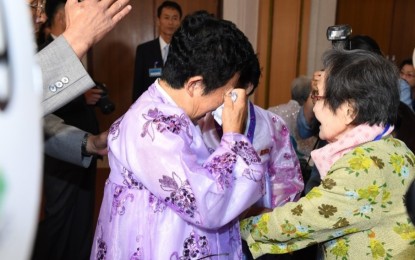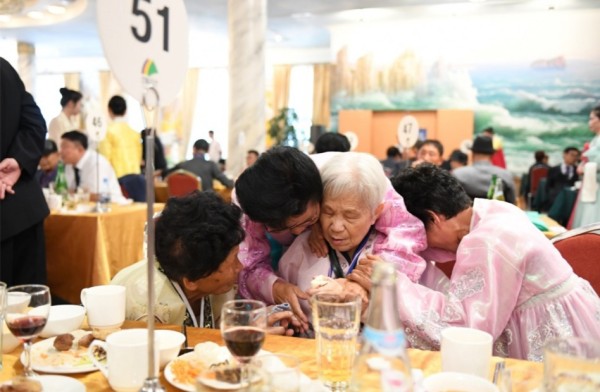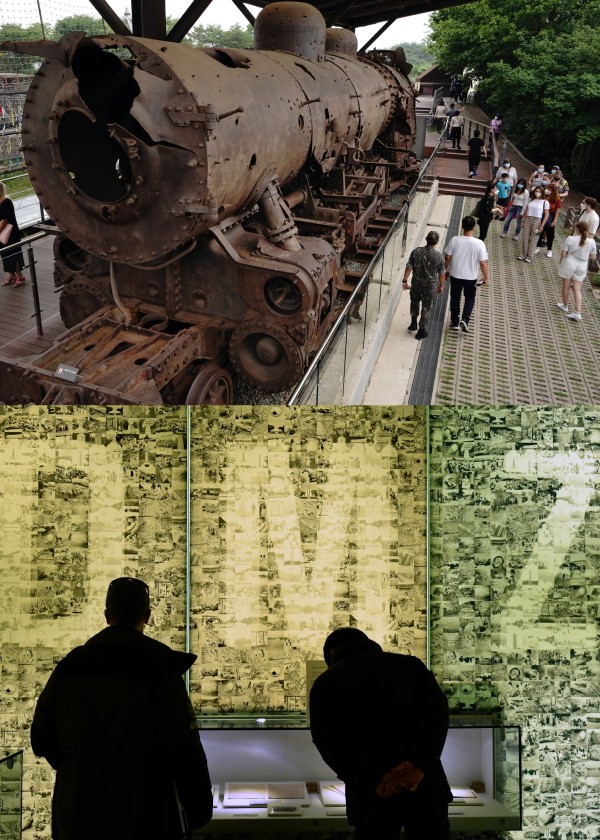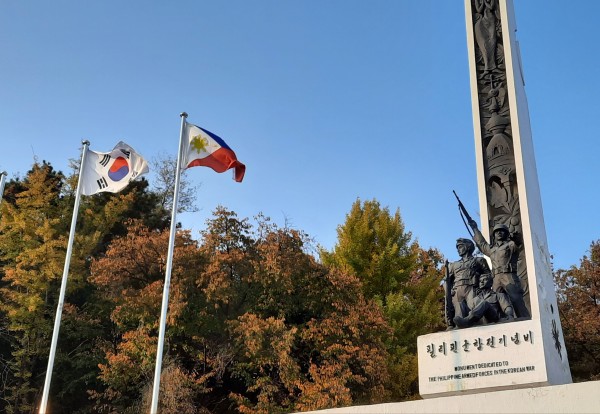[11.28] 한국전쟁 이산가족의 시간은 촉박하다
컨텐츠 정보
- 21,665 조회
본문
한국, 서울 – 70년이 넘었지만 한국전쟁의 혼란을 피해 피난한 몇몇 가족들에게는 과거의 상처가 여전히 깊습니다.
1950년 전쟁 발발로 가족과 헤어진 수천 명 중 한 명인 노인 '강옥녀'에게 그녀의 유일한 소원은 북한에서 온 세 남매를 만나는 것이다.
"금녀", "숙녀", "복희" 보고싶다, 죽기 전에 마지막 소원은 너를 만나서 보는 것이다. 2022년 4월 통일부에 올린 '영상편지'에서 건강하시길 바랍니다.
강씨의 편지는 늙어가는 딸과 아들이 언젠가 부모형제를 만날 수 있기를 바라며 사이버 공간에 남기는 수많은 영상 중 하나일 뿐이다.
남북한의 접촉은 여전히 매우 제한되어 있어 정부가 북한 주민의 생활 상황을 파악하거나 단순히 생사를 확인하는 것조차 어렵습니다.
인구 고령화로 인해 이산가족을 위한 시간이 얼마 남지 않았습니다.
통일부는 1950년대 약 5년 만에 북한에서 온 실향민이 2005년 70만 명으로 급격하게 줄었다고 밝혔습니다.
사이트가 보유할 수 있는 공간이 주어지면 국가에서 지원하는 모임은 추첨을 통해 참여 개미를 선택합니다. 지금까지 서울과 평양 사이에 열린 상봉은 28건에 불과하며 2018년에 마지막으로 대면했다.
1988년에 신청서가 접수된 이후로 133,000명 이상의 가족 구성원이 가능한 상봉에 참여하기 위해 등록했습니다.
이 중 87,404명이 이미 세상을 떠났고 40,000명 이상의 생존자만이 잠재적으로 80세 이상이라고 말했습니다.
'국제 지원'
북한과의 관계를 관장하는 통일부는 이 "긴급한 문제"가 국제 사회로부터 더 많은 지지와 나머지 부분에서 더 많은 지지를 얻을 수 있기를 희망했습니다.
익명을 요구한 외교부 관계자는 최근 필리핀통신(PNA)과의 인터뷰에서 “이번 이슈 테스트는 인권 문제이자 인도주의적 문제인 만큼 국제사회의 많은 관심과 성원을 부탁드린다”고 말했다.
이 관계자는 대유행으로 인한 문제 외에도 북한이 미국과의 군사 훈련 이후 논의를 재개하라는 남한의 요청에 반응하지 않았다고 말했습니다.
통일연구원 이규창 선임연구위원은 생존 이산가족의 최소 82%가 북한에 있는 친족의 생사 여부를 모른다고 말했다.
그는 PNA에 "우리는 생존자보다 죽은 사람이 훨씬 더 많고 등록된 사람의 수에 불과하다"고 말했다. "5년 안에 이 사람들은 아마도 사라질 것입니다."
가족 간의 분리는 전쟁이 해결하지 못한 복잡한 문제 중 하나입니다.
1953년 휴전 이후 수십 년이 지난 지금, 남북한의 분단은 더욱 심화되었습니다.
그러나 한국은 하나의 "통일된" 한반도에 계속해서 희망을 걸고 있습니다.
'더 안전하고 평화로운 지역'
정신적 상처를 치유하고 양측의 번영을 보장하는 것 외에도 이 대통령은 "통일"이 "더 안전하고 평화로운" 지역을 가져올 것이라고 말했다.
북한이 핵무기 프로그램을 지속적으로 추구함에 따라 이 지역은 분쟁의 잠재적인 위험한 발화점으로 남아 있습니다.
앞서 조선민주주의인민공화국은 미국 본토에 도달할 수 있다고 보고된 사거리를 가진 것으로 추정되는 대륙간 탄도 미사일을 지난 몇 주 동안 계속해서 무기 시험을 계속했습니다.
“현재 한반도는 세계에서 가장 전쟁의 위협이 높고 전쟁의 위험이 가장 높은 지역입니다. 한국이 통일되면 이 지역은 더 안전하고 더 많은 평화와 안보를 갖게 될 것입니다.” .
이어 "'윤석열' 새 정부의 비전은 국제사회의 허브국가가 되는 것"이라며 "북한이 비핵화를 포기하고 평화프로세스에 동참하기를 바란다"고 덧붙였다.
하지만 70년 넘게 분단된 남북한이 어떻게 다시 하나가 될 수 있을까요?
이씨는 점차 두 사람 사이의 격차를 해소하고 궁극적으로 두 개의 서로 다른 사회를 하나로 통합하는 경제 및 문화 공동체를 만드는 것부터 시작할 수 있다고 말했습니다.
그는 “6.25전쟁이 있었고 당시 우리 가족이 북한군과 그 반대편에 의해 살해되는 것을 보았기 때문에 사람들 간의 적대감이 가장 큰 걸림돌이라고 생각한다”고 말했다.
이어 “그들과 더 많은 소통과 교류가 있다면 국민 간의 적대감도 줄어들 것”이라고 덧붙였다.
궁극적으로 평화 조약이 체결되어야 합니다.
"우리는 평화 체제로 들어가야 통일이 일어날 수 있습니다."
'기술적으로 진행 중인 전쟁'
1950년 6월 북한군이 남한을 침공하면서 유엔사(UNC)가 창설되었다.
총 7,420명의 필리핀 파견군(PEFTOK)을 파병한 마닐라를 포함하여 최소 22개 주가 남한을 지원했습니다.
1953년 7월 한국의 정전협정이 체결되면서 수백만 명의 민간인을 희생시킨 적대 행위가 중단되고 241km의 비무장지대(DMZ)가 형성되었습니다.
필리핀 파견대는 1955년까지 UNC에서 복무했으며 전사 116명, 부상 99명, 실종 57명을 기록했습니다.
그러나 공식적인 평화협정이 없는 오늘날 남한과 북한은 기술적으로 여전히 전쟁 상태에 있습니다. (PNA)
This is the Original Article from PNA NEWS
[11.28] The time is running- out for Korean War-separated families
SEOUL, South Korea – Over 70 years have passed but for several families who fled the chaos during the Korean War, the wound from the past still runs deep.
For the elderly "Kang Ok-nyeo," one of the thousands who got separated from a family member when the war broke out in 1950, her one wish is to meet her three siblings from North Korea.
"Geum-no," "Suk-nyeo," "Bok-hee" I miss you, before I die, my last wish is to meet and see you. I hope you are healthy," she said in a "video message" posted at the Ministry of Unification in April 2022.
"Kang's" letter is just one of the many clips aging daughters and sons are leaving on cyberspace in the hopes that their parents and siblings could one day meet.
The Contact between the two Koreas remains highly restricted, making it difficult for Seoul to find out the living conditions of those in the North or even simply to confirm whether they are dead or alive.
With a now aging population, time for these divided families is running out.
The Ministry of Unification said there was roughly five years lion, of war-displaced Koreans from the North in the 1950s, which dramatically went down to 700,000 in 2005.
State-supported meet-ups, given the space a site could hold, select participate ants via lottery. To date, there have only been 28 reunions organized between Seoul and Pyongyang, with the last face-to-face meeting held in 2018.
Since applications were opened in 1988, more than 133,000 family members have registered to participate in any possible reunion.
Of this figure, the ministry said 87,404 have already passed away leaving only more than 40,000 survivors to potentiallyority of whom are age 80 and above.
'International support'
The ministry, which oversees relations with the North, hoped this "urgent issue" could garner more support and in the rest from the international community.
"This issue test also a human rights issue and humanitarian issue so I like to ask for more support and interest from the international community," a ministry official who requested anonymity said in a recent interview with the Philippine News Agency (PNA).
On top of the challenges posed by the pandemic, the official said North Korea had been unresponsive to Seoul's call to revive discussions in the wake of the latter's military drills with the United States.
Korea Institute for National Unification (KINU) senior research fellow "Lee Kyu-Chang" said at least 82 percent of the surviving separated families don't know whether their kin in the North is alive.
"We have a lot more dead people than the survivors and these are just the number of those who are registered," he told the PNA. "In five years, these people probably would be gone."
Separation among families is among the many complex issues the war has left unresolved.
Decades, since the ceasefire took place in 1953, the division between the two Koreas, had no doubt grown deeper.
But Seoul continues to pin hope on a one "unified" Korean Peninsula.
'Safer, peaceful region'
Beyond healing mental wounds and ensuring prosperity for both sides, Lee said "unification" would also bring about a "safer and peaceful" region.
With the North's unabated pursuit of a nuclear weapons program, the region remains a potentially dangerous flashpoint for conflict.
The Democratic People's Republic of Korea earlier fired a presumed intercontinental ballistic missile with a reported range that can reach the mainland United States, continuing a flurry of weapons tests over the past weeks.
"At the moment the Korean Peninsula is the region with the highest threat of war and highest risk of war in the world. If Korea's unified then the region would be safer and it's going to have more peace and security," "Lee," said.
"The vision of the new "Yoon Suk-yeol" government is becoming a hub country in the international community. He wants North Korea to give up on denuclearization and become part of the peace process," he added.
But how can the two Koreas, split for more than seven decades, become one again?
"Lee," said it could start by gradually bridging the gap between its two people and eventually creating economic and cultural communities to integrate two different societies into one.
"I think the biggest block is the hostility of people to each other because we had the Korean War and at that time, we saw members of our family get killed by North Korean soldiers and the opposite side," he shared.
"If we have more communication and exchanges with them, that would lessen that hostility among people," he added.
Ultimately, a peace treaty must be signed.
"We need to move into a peaceful system and then reunification can happen," "Lee," said.
'Technically ongoing war'
North Korean forces invaded South Korea in June 1950, prompting the formation of the United Nations Command (UNC).
At least 22 states supported the South, including Manila which sent a total of 7,420 Filipino soldiers under the Philippine Expeditionary Force to Korea (PEFTOK).
When the Korean Armistice Agreement was signed in July 1953, the hostilities that killed millions of civilians were suspended and the 241-kilometer-long demilitarized zone (DMZ) was formed.
The Philippine contingent served under the UNC until 1955 and suffered 116 killed in action, 99 wounded, and 57 missing.
But with no official peace agreement, South and North Korea today are technically still in a state of war. (PNA)
관련자료
-
이전
-
다음





